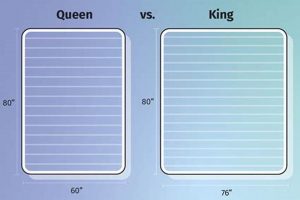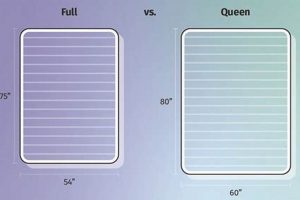The terms “firm” and “soft,” when applied to mattresses, describe the degree to which the sleep surface yields under pressure. A firmer sleeping platform offers less give, providing a more rigid feel, while a softer sleeping platform allows for greater compression, resulting in a plusher sensation. This characteristic significantly impacts spinal alignment and pressure point distribution during sleep.
Selecting an appropriate sleep surface based on its firmness level is crucial for promoting restful sleep and minimizing discomfort. Historically, mattress construction materials dictated the achievable firmness. However, modern manufacturing techniques and diverse material combinations allow for a wide spectrum of firmness options, catering to a broader range of individual needs and preferences. Choosing wisely can contribute to improved sleep quality and reduced back pain.
The following sections will delve into specific considerations for selecting an appropriate mattress firmness, exploring factors such as sleeping position, body weight, and potential health conditions. Understanding these elements allows consumers to make informed decisions regarding their sleep environment and overall well-being.
Considerations for Mattress Firmness Selection
The following points offer guidance in selecting a mattress with appropriate firmness, balancing support and comfort based on individual needs.
Tip 1: Assess Sleeping Position. Side sleepers often benefit from a softer sleeping platform to accommodate shoulder and hip compression, maintaining spinal alignment. Back sleepers generally require a firmer surface for adequate lumbar support. Stomach sleepers may need a firmer mattress to prevent excessive sinking of the midsection, reducing lower back strain.
Tip 2: Evaluate Body Weight. Individuals with higher body mass typically require a firmer mattress to prevent excessive sinking and maintain proper spinal alignment. Lighter individuals may find a softer mattress more comfortable, allowing for adequate contouring and pressure relief.
Tip 3: Consider Spinal Alignment. The mattress should promote a neutral spinal position during sleep. Test different firmness levels to determine which option best supports the natural curvature of the spine in the preferred sleeping position.
Tip 4: Address Pressure Points. Be mindful of areas prone to pressure build-up, such as shoulders, hips, and knees. Softer mattresses can alleviate pressure on these points, while firmer mattresses may exacerbate discomfort.
Tip 5: Factor in Health Conditions. Individuals with back pain, arthritis, or other musculoskeletal issues should consult with a healthcare professional for recommendations on mattress firmness. Certain conditions may benefit from specific support characteristics.
Tip 6: Recognize Personal Preference. While general guidelines exist, individual comfort is paramount. Try out various mattress options, considering the preceding factors, to determine the optimal firmness level.
Tip 7: Inquire About Trial Periods. Many mattress retailers offer trial periods. This allows the individual to assess the mattress’s suitability over an extended duration, ensuring a comfortable and supportive sleep experience.
Selecting the appropriate mattress firmness significantly impacts sleep quality and overall well-being. By carefully considering sleeping position, body weight, spinal alignment, pressure points, health conditions, personal preference, and trial periods, individuals can make informed decisions to optimize their sleep environment.
The subsequent sections will provide additional information on specific mattress materials and construction techniques, further aiding in the selection process.
1. Spinal Alignment
Proper spinal alignment during sleep is paramount for musculoskeletal health and overall well-being. A mattress that fails to support the natural curvature of the spine can contribute to back pain, stiffness, and discomfort. The connection between spinal alignment and mattress firmness is direct: the ideal mattress firmness is the one that allows the spine to maintain its natural alignment while lying down. A mattress that is too soft will allow the heavier parts of the body (hips and shoulders) to sink too deeply, leading to spinal misalignment, particularly for back and stomach sleepers. Conversely, a mattress that is too firm will not allow for proper contouring, placing undue pressure on specific points of the body and potentially leading to misalignment, especially for side sleepers.
Consider the example of a side sleeper with broad shoulders. A mattress that is too firm will create a gap between the mattress and their waist, leading to lateral spinal flexion. Over time, this can lead to muscular imbalances and pain. A softer mattress, or one with sufficient conforming properties, would allow the shoulders to sink slightly, closing the gap and maintaining a more neutral spinal position. Conversely, a back sleeper with poor posture may find that a very soft mattress exacerbates their lordosis (exaggerated lower back curvature), leading to discomfort. A firmer mattress would provide more support, preventing excessive sinking and promoting a healthier spinal alignment. The practical significance of this understanding lies in the ability to select a sleep surface that actively promotes health and comfort rather than contributing to pain and dysfunction.
In summary, selecting the appropriate mattress firmness is critical for maintaining optimal spinal alignment during sleep. Factors such as sleeping position and body weight must be considered to ensure the chosen mattress provides adequate support and contouring. Failure to prioritize spinal alignment can lead to chronic pain and decreased quality of life, highlighting the importance of informed mattress selection. Therefore, understanding the relationship between mattress firmness and spinal alignment is a fundamental aspect of ensuring restful and restorative sleep.
2. Pressure Relief
The capacity of a sleep surface to alleviate pressure point concentration is a critical factor in determining sleep quality and comfort. Mattress firmness directly influences this ability. Softer mattresses tend to conform more readily to body contours, distributing weight over a larger surface area and thereby reducing localized pressure. Firmer mattresses, conversely, offer less give, potentially leading to increased pressure point loading, particularly at bony prominences such as hips and shoulders. Inadequate pressure relief can disrupt sleep cycles, causing tossing and turning and ultimately leading to fragmented and non-restorative rest. For instance, an individual with arthritis may experience significant pain exacerbation on a firm mattress due to increased pressure on inflamed joints. Conversely, a person with no specific health issues might still experience discomfort from a firm surface due to pressure buildup at common points. Understanding this connection allows for informed decision-making when selecting a mattress.
The effect of mattress firmness on pressure relief can be further elucidated by considering sleeping positions. Side sleepers, due to their concentrated weight distribution on a smaller surface area, often benefit significantly from softer mattresses capable of accommodating the contours of the shoulder and hip. Back sleepers, while enjoying a more even weight distribution, still require pressure relief at the lumbar region and sacrum. A medium-firm mattress, in this case, might offer an optimal balance of support and pressure distribution. The importance of pressure relief extends beyond mere comfort; prolonged pressure concentration can impede blood flow to localized tissues, potentially contributing to the development of pressure ulcers, especially in individuals with limited mobility or impaired circulation. The specific materials used in mattress construction, such as memory foam or latex, also play a significant role in determining pressure relief characteristics. These materials exhibit viscoelastic properties, allowing them to conform to the body and distribute weight effectively.
In summary, the relationship between mattress firmness and pressure relief is a complex and multifaceted consideration. A softer sleeping surface generally provides superior pressure relief by distributing weight across a larger area. However, the optimal level of firmness depends on individual factors such as sleeping position, body weight, and underlying health conditions. Ignoring the importance of pressure relief can lead to discomfort, disrupted sleep, and potential health complications. Therefore, individuals should carefully consider their unique needs and preferences when selecting a mattress, prioritizing pressure relief to promote restful and restorative sleep and overall physical well-being.
3. Body Weight
Body weight is a significant determinant when selecting mattress firmness. A direct correlation exists: increased body mass typically necessitates a firmer sleep surface, while lower body mass may be better suited to a softer mattress. The underlying principle relates to support and spinal alignment. A heavier individual on a too-soft mattress will experience excessive sinking, disrupting spinal alignment and potentially causing back pain. Conversely, a lighter individual on a too-firm mattress may not experience adequate contouring, leading to pressure points and discomfort. For instance, a person weighing 250 pounds will likely require a firmer mattress to maintain a neutral spine during sleep, compared to someone weighing 130 pounds who might find a medium or soft mattress more comfortable and supportive.
The impact of body weight on mattress selection also influences the longevity of the mattress itself. A heavier individual will place more stress on the mattress components, potentially leading to premature sagging and reduced support over time, especially in softer models. Consequently, considering material density and construction is crucial. Mattresses designed for heavier individuals often incorporate reinforced coils or high-density foam to provide adequate support and durability. Real-world application involves trial and error, and many mattress retailers offer guidelines based on weight ranges. However, these guidelines serve as a starting point, and individual preferences and sleeping positions remain important considerations.
In summary, body weight is a critical factor in determining appropriate mattress firmness. Selecting a mattress that adequately supports body weight is essential for maintaining spinal alignment, preventing pressure points, and ensuring mattress longevity. Disregarding this factor can lead to discomfort, pain, and a shortened lifespan of the sleep surface. Therefore, assessing body weight and considering mattress construction are vital steps in optimizing sleep quality and overall well-being.
4. Sleeping Position
Sleeping position significantly dictates the optimal level of mattress firmness for ensuring spinal alignment and minimizing pressure points. The three primary sleeping positionsside, back, and stomacheach interact differently with a sleep surface. Side sleepers, characterized by concentrated weight distribution along the lateral aspect of the body, typically benefit from a softer sleeping platform. This allows the shoulder and hip to sink into the mattress, maintaining a neutral spinal alignment. A mattress that is too firm will create pressure points on these bony prominences, potentially leading to discomfort and disrupted sleep. For example, a side sleeper on an overly firm mattress might experience shoulder pain, necessitating frequent repositioning throughout the night. In essence, sleeping position informs firmness decisions.
Back sleepers, enjoying a more even weight distribution across the surface of the mattress, generally require a firmer sleep surface to provide adequate lumbar support. A mattress that is too soft will allow the hips to sink, potentially exaggerating the natural curvature of the spine and leading to lower back pain. A medium-firm mattress typically strikes an ideal balance for back sleepers, offering both support and a degree of contouring. Conversely, stomach sleepers typically require the firmest sleeping surface to prevent excessive sinking of the midsection. This is crucial for maintaining spinal alignment and preventing lower back strain. A soft mattress can cause the stomach to sink, arching the back and leading to discomfort. A real-world consideration includes individuals who switch positions throughout the night; in such cases, a medium-firm mattress often provides the best compromise, offering sufficient support for back sleeping and a degree of pressure relief for side sleeping. Position also impacts how firmness is perceived by sleepers.
In summary, sleeping position is a key determinant of appropriate mattress firmness. Side sleepers generally benefit from softer mattresses to alleviate pressure points, while back and stomach sleepers typically require firmer mattresses to maintain spinal alignment. Understanding the relationship between sleeping position and mattress firmness is essential for selecting a sleep surface that promotes comfort, spinal health, and restorative rest. Challenges arise when individuals frequently change positions; however, a medium-firm mattress often provides a viable solution. The broader theme underscores the importance of personalized sleep solutions, recognizing that optimal mattress firmness is not a one-size-fits-all concept.
5. Personal Preference
Personal preference, while seemingly subjective, represents a critical component in the determination of optimal mattress firmness. The perceived comfort of a sleep surface, directly influencing sleep quality, is inherently linked to individual sensory experiences and prior conditioning. Objective metrics, such as pressure mapping and spinal alignment assessments, provide valuable data, but ultimately, the individual’s subjective feeling on the mattress dictates satisfaction. For example, one individual may find the conforming nature of a soft mattress exceptionally comfortable and conducive to relaxation, while another may perceive the same mattress as lacking support and contributing to a feeling of instability. This disparity highlights the individualized nature of comfort perception and its crucial role in mattress selection.
The influence of personal preference extends beyond immediate comfort. Long-term satisfaction with a mattress correlates strongly with the alignment between the individual’s subjective expectations and the actual sleep experience. An individual who consistently anticipates a firm, supportive feel may experience dissatisfaction with a softer mattress, even if objective measures suggest it is promoting proper spinal alignment. Conversely, someone accustomed to the plush feel of a soft mattress may struggle to adapt to a firmer surface, experiencing discomfort and disrupted sleep. Furthermore, pre-existing medical conditions can shape personal preferences. Someone with chronic back pain, for instance, might develop a strong preference for a specific firmness level based on its impact on their symptoms, irrespective of general recommendations. Consider two people with different medical conditions and what type of mattress is best. One may have scoliosis which requires a soft surface. An other may have osteoarthritis which would only benefit from a firm mattress.
In summary, while factors like sleeping position, body weight, and spinal alignment offer objective guidelines for mattress selection, personal preference functions as the ultimate arbiter of suitability. The subjective feeling of comfort, shaped by individual sensory experiences and expectations, significantly impacts sleep quality and long-term satisfaction. Recognizing the importance of personal preference necessitates a tailored approach to mattress selection, emphasizing the need for extended trial periods and personalized consultations to ensure the chosen sleep surface aligns with individual needs and expectations. Ultimately, a mattress perceived as comfortable is far more likely to promote restful sleep and contribute to overall well-being, regardless of objective metrics.
Frequently Asked Questions
The following section addresses common inquiries regarding mattress firmness, aiming to provide clarity and guidance for informed decision-making.
Question 1: What is the primary difference between a firm and a soft mattress?
The core difference lies in the degree of give or compression. A firm mattress offers minimal yield under pressure, providing a more rigid feel. A soft mattress allows for greater compression, resulting in a plusher sensation. This characteristic affects spinal alignment and pressure distribution.
Question 2: How does sleeping position influence the ideal mattress firmness?
Sleeping position dictates the support required to maintain spinal alignment. Side sleepers often benefit from softer mattresses to accommodate shoulder and hip compression. Back sleepers typically require firmer surfaces for lumbar support. Stomach sleepers generally need the firmest options to prevent midsection sinking.
Question 3: Does body weight factor into mattress firmness selection?
Body weight is a significant consideration. Individuals with higher body mass typically require firmer mattresses to prevent excessive sinking and maintain spinal alignment. Lighter individuals may find softer mattresses more comfortable, allowing for adequate contouring.
Question 4: Can mattress firmness alleviate back pain?
Appropriate mattress firmness can contribute to back pain reduction by promoting spinal alignment and minimizing pressure points. However, severe or chronic back pain warrants consultation with a healthcare professional for tailored recommendations.
Question 5: Are there objective ways to determine ideal mattress firmness?
Pressure mapping and spinal alignment assessments offer objective data regarding pressure distribution and spinal posture. However, subjective comfort remains a crucial factor in determining long-term satisfaction.
Question 6: Should a mattress topper be considered as an alternative to a new mattress with different firmness?
A mattress topper can modify the feel of an existing mattress. A soft topper can add plushness to a firmer surface, while a firmer topper can provide additional support to a softer mattress. However, a topper is not a substitute for a structurally supportive mattress if the underlying mattress is worn or inadequate.
Selecting the appropriate mattress firmness involves careful consideration of individual factors such as sleeping position, body weight, and personal preference. Understanding these elements empowers consumers to make informed decisions regarding their sleep environment and overall well-being.
The following sections will address material differences.
Firm vs Soft Mattress
The preceding exploration of the dichotomy between firm and soft mattresses underscores the significance of informed decision-making in sleep surface selection. The relative merits of each option are contingent upon a confluence of factors, including individual sleeping position, body weight, spinal health considerations, and subjective preference. No singular solution exists; rather, the ideal choice represents a carefully considered alignment of these elements to optimize spinal alignment, pressure relief, and overall sleep quality.
The selection process should prioritize empirical evaluation and, when feasible, professional consultation. Ignoring the nuances of individual needs in favor of generalized recommendations carries the potential for compromised sleep and related health consequences. Therefore, a proactive and discerning approach is paramount in securing a sleep environment conducive to restorative rest and long-term well-being.







![Saatva vs Leesa Mattress: Which Bed Wins? [2024] Organic & Natural Mattress Buyer’s Guide: Non-Toxic Sleep Solutions Saatva vs Leesa Mattress: Which Bed Wins? [2024] | Organic & Natural Mattress Buyer’s Guide: Non-Toxic Sleep Solutions](https://mattressworldpa.com/wp-content/uploads/2025/07/th-1084-300x200.jpg)